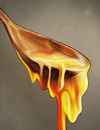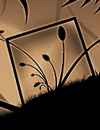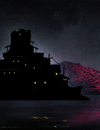Exile's Rose

|
Beyond this point lie spoilers for Fallen London, Sunless Sea, Sunless Skies, or Mask of the Rose. This may include midgame or minor Fate-locked content. Proceed with caution. You can find out more about our spoiler policy here. |
"Plucked from the walls of Hell. How far you'll go to win your intended's favour. Or perhaps an indication of where they ought to go."
"The flower pressed to the paper, its petals flattened like ink. Velvet to the touch and wet with unstolen nectar, the Exile's Rose is redolent of dark promises made at midnight. London's veterans returned from the war on Hell wearing them on their breasts."[1]
The Exile's Rose is an otherworldly flower used in the manufacture of prisoner's honey and gaoler's honey.
The Key to Dreams[edit]
"I have seen fairer roses. But few make so clear a statement. Hell tends its gardens well. Thank you."[2]

Grown in fields near the walls of Hell,[3][4] Exile's Rose is a thorny flower that resembles a rose[5] with jet-black petals.[6][7] It symbolizes dark promises made at midnight; veterans of the Campaign of '68 returned home wearing Exile's Roses on their uniforms, indicating that they were forced into grim vows or pacts during their tours of duty.[8] People who consume Exile's Rose depart for Parabola and never return,[9] but its petals are apparently safe to eat and are an ingredient in Zzoup.[10] Devils seem quite fond of Exile's Rose, as they describe it poetically with an air of nostalgia.[11]

Lamplighter bees that have fed exclusively on the nectar of Exile's Rose produce prisoner's honey,[12] a drug that temporarily transports its imbibers to Parabola.[13] Hell exports prisoner's honey to London in large quantities,[14] as it provides an easy and consistent means to access Parabola.[15][16] The destruction of the Exile's Rose would bring ruin to honey-addicts and impact Hell's revenue,[14] and would risk closing the border between London and Parabola entirely.[17] It is implied that Hell cannot easily replenish its stocks of Exile's Rose should they be depleted,[18] so they employ ruthless, non-humanoid devils to guard their rose fields.[19]

It is unclear whether or not the Exile's Rose originates from Hell proper.[20][21] It is said to only grow close to Hell,[22] but according to the writings of Pliny the Elder, it also appears on the Surface in "sacred places from Pontus to Baetica."[9] The realm of Caduceus in Eleutheria is filled with roses of all colors,[23] including black;[24] this place was where the devils fled to Parabola after their rebellion against the Judgements,[25] but there is no explicit connection between the roses of Caduceus and Exile's Rose.
According to the Order Serpentine, the Fingerkings grew lonely in Parabola,[26] and asked the "grumpiest bee in both worlds" (likely a representation of the devils) for help. The bee retrieved the Exile's Rose from a "far place,"[21] and used the flower's "property of passage" between worlds to concoct prisoner's honey and transport human dreamers to Parabola.[27] In exchange, the Fingerkings granted the devils "one-fifth" of their proceeds from the use of this honey.[28]
Red, Red Roses[edit]
"When lamplighter bees suck the nectar of the crimson strain of exile's rose, they are driven to madness. They enter the brains of humans and harvest their memories. Those memories are instilled in red honey. Each sip is a burst of memory on the tongue."[29]
"I have, I fear, at last determined the cause of our poor Leopold's sad disappearance. You will recall that I sent by the Borneo a very considerable collection of [illegible] ... identified one variety as the sinister exile's rose of the Bosphorus. Sophia had long admired their colour [illegible] ... gardens here about the Government-house [illegible] ... although here they call it 'lion's rose'."[30]

The Exile's Rose may be crossbred with another flower from Hell to produce a red-petaled variant.[31][32] When Lamplighter Bees consume pollen from these hybrids, they go mad and extract memories from the minds of those nearby, producing red honey.[33] In 1821, Stamford Raffles imported a red strain of Exile's Rose to Singapore (possibly the aforementioned variant), identifying them as the "sinister exile's rose of the Bosphorus" and "lion's rose." Leopold, his son, encountered these flowers and vanished from the Surface;[34][35] he later reappeared in the Neath and became the Pirate-King of the Isle of Cats.[36]
Historical and Cultural Inspirations[edit]
Pontus is part of Anatolia in modern-day Turkey, whereas Baetica was a Roman province on the Iberian peninsula. The Bosphorus is a strait that divides Istanbul, Turkey. This specific regional indication implies that Exile's Rose was inspired by Rhododendron ponticum, whose honey infamously contains a group of neurotoxins that result in cardiac and consciousness-altering effects in humans.[37] Unlike Exile's Rose, this species of rhododendron blooms purple or pink.
References[edit]
|